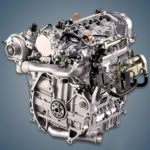The 1.2-liter Peugeot EB2DT or HNZ turbo engine has been produced by the concern since 2014 and is installed on models with the PureTech 110 index, but now it is gradually being replaced by the EB2ADTD engine. There are a number of modifications to such a power unit, such as EB2ADT or EB2DTM.
Engines of the EB family: EB0, EB2, EB2M, EB2DT, EB2DTS, EB2ADTX.
Specifications
| Production years | since 2014 |
| Displacement, cc | 1199 |
| Fuel system | direct injection |
| Power output, hp | 110 |
| Torque output, Nm | 205 |
| Cylinder block | aluminum R3 |
| Block head | aluminum 12v |
| Cylinder bore, mm | 75 |
| Piston stroke, mm | 90.5 |
| Compression ratio | 10.5 |
| Features | balancers |
| Hydraulic lifters | no |
| Timing drive | belt |
| Phase regulator | dual VTi |
| Turbocharging | Garrett NGT1341LSZ |
| Recommended engine oil | 0W-30 |
| Engine oil capacity, liter | 3.5 |
| Fuel type | petrol |
| Euro standards | EURO 5/6 |
| Fuel consumption, L/100 km (for Peugeot 208 2015) — city — highway — combined |
5.6 3.8 4.5 |
| Engine lifespan, km | ~270 000 |
| Weight, kg | 98 |
The engine was installed on:
- Citroen Berlingo II (B9) in 2016 – 2018; Berlingo III (K9) in 2018 – 2019;
- Citroen C3 II (A51) in 2014 – 2017; C3 III (B61) since 2017;
- Citroen C3 Aircross II (A88) since 2017;
- Citroen C3 Picasso I (A58) in 2015 – 2017;
- Citroen C4 II (B71) in 2015 – 2018;
- Citroen C4 Picasso II (B78) in 2016 – 2018;
- Citroen C4 Cactus I (E3) in 2014 – 2018; C4 Cactus II (F3) in 2018 – 2020;
- Citroen DS3 I (A55) in 2014 – 2016;
- DS DS3 I (A55) in 2016 – 2019;
- Opel Combo E (X19) in 2018 – 2019;
- Opel Crossland X (P17) since 2017;
- Peugeot 208 I (A9) in 2015 – 2019;
- Peugeot 2008 I (A94) in 2015 – 2019;
- Peugeot 308 II (T9) in 2014 – 2021; 308 III (P5) since 2021;
- Peugeot Partner II (B9) in 2016 – 2018;
- Peugeot Rifter I (K9) in 2018 – 2019.
Disadvantages of the EB2DT engine
- Motors of the first years of production came under a recall campaign due to crankshaft axial play;
- The presence of direct injection nozzles contributes to the formation of carbon deposits on the valves;
- Also, after 100,000 km of run, units of this family usually consume oil;
- However, the main design miscalculation here is the timing belt in an oil bath;
- He does not go the prescribed 180,000 km, and the products of his wear clog the oil channels.






